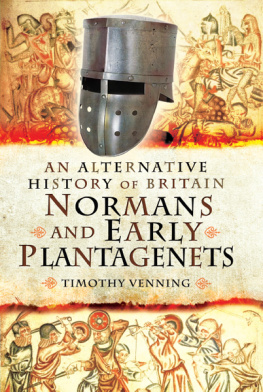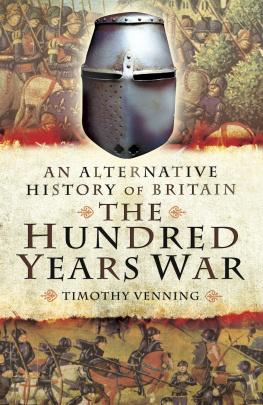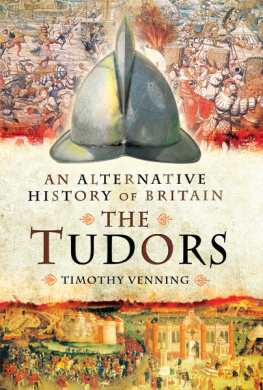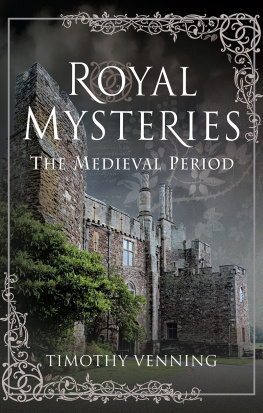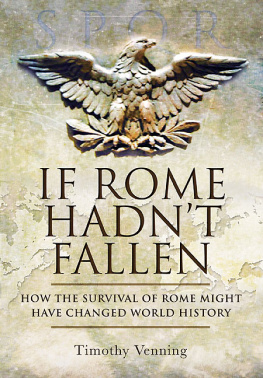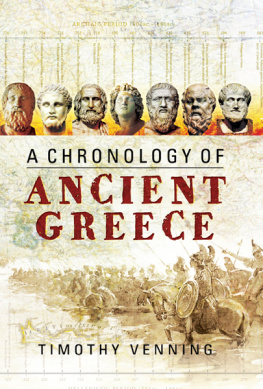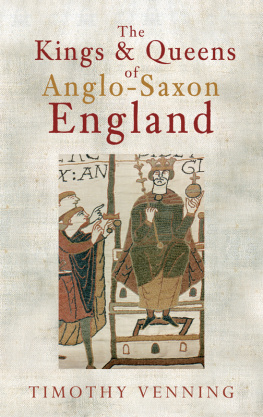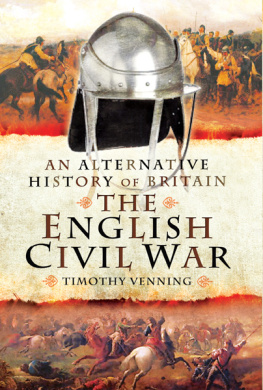First published in Great Britain in 2014 by
Pen & Sword Military
an imprint of
Pen & Sword Books Ltd
47 Church Street
Barnsley
South Yorkshire
S70 2AS
Copyright Timothy Vennings 2014
HARDBACK ISBN: 978-1-78346-271-1
PDF ISBN: 978-1-47383-633-4
EPUB ISBN: 978-1-47383-457-6
PRC ISBN: 978-1-47383-545-0
The right of Timothy Venning to be identified as Author of this Work
has been asserted by him in accordance with the Copyright, Designs and
Patents Act 1988.
A CIP catalogue record for this book is available from the British Library.
All rights reserved. No part of this book may be reproduced or transmitted in
any form or by any means, electronic or mechanical including photocopying,
recording or by any information storage and retrieval system, without
permission from the Publisher in writing.
Typeset in 11pt Ehrhardt by
Mac Style, Bridlington, E. Yorkshire
Printed and bound in the UK by CPI Group (UK) Ltd, Croydon, CRO 4YY
Pen & Sword Books Ltd incorporates the imprints of Pen & Sword
Archaeology, Atlas, Aviation, Battleground, Discovery, Family History,
History, Maritime, Military, Naval, Politics, Railways, Select, Transport,
True Crime, and Fiction, Frontline Books, Leo Cooper, Praetorian Press,
Seaforth Publishing and Wharncliffe.
For a complete list of Pen & Sword titles please contact
PEN & SWORD BOOKS LIMITED
47 Church Street, Barnsley, South Yorkshire, S70 2AS, England
E-mail:
Website: www.pen-and-sword.co.uk
Contents

Chapter One
The Norman State
The unlikely succession of Henry I: what if his older brothers Robert or Richard had ruled, and did he murder William II?
T he succession to England from 1087 to 1154 owed a lot to fortuitous circumstances, in that it was unusual for Western Europe, where the major states more often descended through a fathereldest son line most notably in France, which did not deviate once from this between Hugh Is accession in 987 and John Is death in 1316. (The Holy Roman Empire descended more obliquely, but it was prey to the ambitions of competing families and was not a geographically compact bloc of inherited lands.) The problem of female succession that afflicted England after Henry Is only sons death in 1120 was not apparent in Castile, where Alfonso VIs son also died unexpectedly (in battle) and his daughter Urraca was able to succeed in 1109 as did Baldwin IIs eldest daughter Melissende in the Kingdom of Jerusalem in 1131. The county later kingdom of Portugal, a minor part of Alfonsos realm, was inherited by his other, illegitimate, daughter, Teresa, and her husband. Those states ruled by a king that had irregular succession were usually due to civil war or repeated rebellion among a number of rival lines descended from the sons of one dominant ancestor, as in Denmark after 1134 (the line of Swein Estrithson) and Norway after 1130 (the line of Magnus Bare Leg). A similar fate befell the weaker Duchy/Kingdom of Bohemia, while in the North-East of Europe, Poland (after 1138) and Russia (after 1054) remained technically one state but were in reality divided up into rival sub-states over which one senior ruler might from time to time have an honorary primacy.
The divided inheritance of 1087 not the norm for the era in Western Europe?
The division of an expansionist rulers lands among his sons on his death on William Is death in 1087 in England had a parallel thrice in Spain, where Ferdinand I (younger son of the King of Navarre) had inherited Castile from his mother in 1035 and taken over his wife s brother Vermudos Leon by conquest in 1037. Ferdinands father, Sancho the Great of Navarre, had already divided his own lands among three sons Navarre for one, Castile for a second, and Aragon for the third. On Ferdinand Is death in 1065 his united kingdom of Castile and Leon was divided between his sons Sancho and Alfonso, but the former disinherited the latter and was murdered, enabling his victim to take over both kingdoms (1072) an approximate parallel with the fratricidal jealousy and possible fratricide among William Is sons. Alfonso VI passed on the reunited kingdom to his daughter Urraca and grandson Alfonso VII, but when the latter died in 1157 it was divided between two sons (Sancho and Ferdinand) again.
Dividing up the late rulers lands among his sons was not standard legal tradition in Williams homeland of northern France in the eleventh and twelfth centuries, with the Kings Isle de France patrimony and lesser dukes and counts dominions usually going to the eldest son. (The question of what to do with conquered lands did not usually apply as the political order was relatively stable.) The only repeated division within one family was of the counties of Blois and Champagne, which were not geographically contiguous anyway. Normally the younger sons could expect at best a minor sub-state that could not militarily rival their elders lands as with the lands given to younger sons of the Kings of France or Counts of Anjou. The largest bloc of lands, with the senior title, went to the oldest son unless he was incapable or a cleric (as, for example, with future King Stephens oldest brother in Blois, William, who, according to historian William of Newburgh, was set aside by his mother due to deficiency in intelligence.) More often a younger son had to fend for himself and find an heiress, as future King Stephen, third or fourth son of Count Stephen of Blois, did with the county of Boulognes heiress, Matilda. He then received the County of Mortain in Normandy from his mothers brother, Henry I of England and Normandy. Normandy had never been divided on the occasions when a Duke had two sons (e.g. William Is father and uncle in 1026); when new Duke Robert set up his younger brother Henry (the future king) in the Cotentin there as a powerful vassal c.1090 this was probably forced by Henry rather than voluntary generosity. Scandinavian kingdoms were divided at times but between co-kings with one usually senior, e.g. Harald Hardradis sons in 1066 and the sons of Magnus Bareleg in 1103. The Normans other dominions, in southern Italy, passed from one son of Tancred de Hauteville to another in the 1040s and 1050s rather than being divided, although this was due to pragmatism a united state was needed to fight its many foes and the Count/Duke could not trust his brothers with mini-states of their own and this new state lacked tradition. When Sicily was conquered by the family of Tancred in the late 1060s it became a separate state under the younger brother, Roger, of the current Duke Robert Guiscard (for military efficiency in an ongoing war against the Arabs as much as out of Rogers rights). Guiscard notably disinherited his elder son, Bohemund, his most promising general and the likelier candidate to win the militaristic nobles backing, from his mainland Duchy in favour of his younger son, Roger Borsa, and let him inherit only a minor county (Taranto). That incident, in 1085 so fresh in peoples memories when William I died, was not, however, an exact parallel the two young men had different mothers and Rogers was a local Lombard heiress, the warlike Sichelgaita who took part in battles, so the areas Lombards would obey him sooner than Bohemund. The latter, like Robert of Normandy in 1087, attempted to reverse the grant of a larger state to his younger brother by war but did not have the military resources to do so and had to give up; he consoled himself with the Duchy of Antioch when the First Crusade commenced and later made a bold bid to take over the entire Byzantine Empire (1107). Bohemund and Robert of Normandy, indeed, served as colleagues on the Crusade where Robert showed that he did not lack military competence or bravery. Normandys neighbouring North French states in Flanders, Maine, Anjou, and Brittany (the latter Celtic by genetic origin and culture not French) usually descended as one polity, from father to son or from brother to brother but were occasionally seized by a disgruntled relative in revolts. In the Scandinavian world from which the Normans ancestors had come to France in the 900s, a divided inheritance was only common in the Jarldom of Orkney, held by the distant cousins of the Dukes of Normandy the founding Duke Rollo/Hrolf the Walker, allegedly too fat to ride a horse, had been son of Jarl Rognvald of More in Norway. But there the sons of a deceased Jarl usually shared the small state out equally rather than having one as the dominant ruler, though the eldest was usually senior. Natural death or (more usually) fratricide duly elevated one contender to sole rule. There was one example of a youngest son in a seemingly hopeless situation triumphing as Henry I of England did by luck and his wits, namely Jarl Thorfinn Raven-Feeder (r. 1015 to c. 1065) who had outwitted and outlived his feuding elder brothers and nephews. But there is no evidence of any influence of Viking Orkney dynastic practice on the Francified Norman state.
Next page
